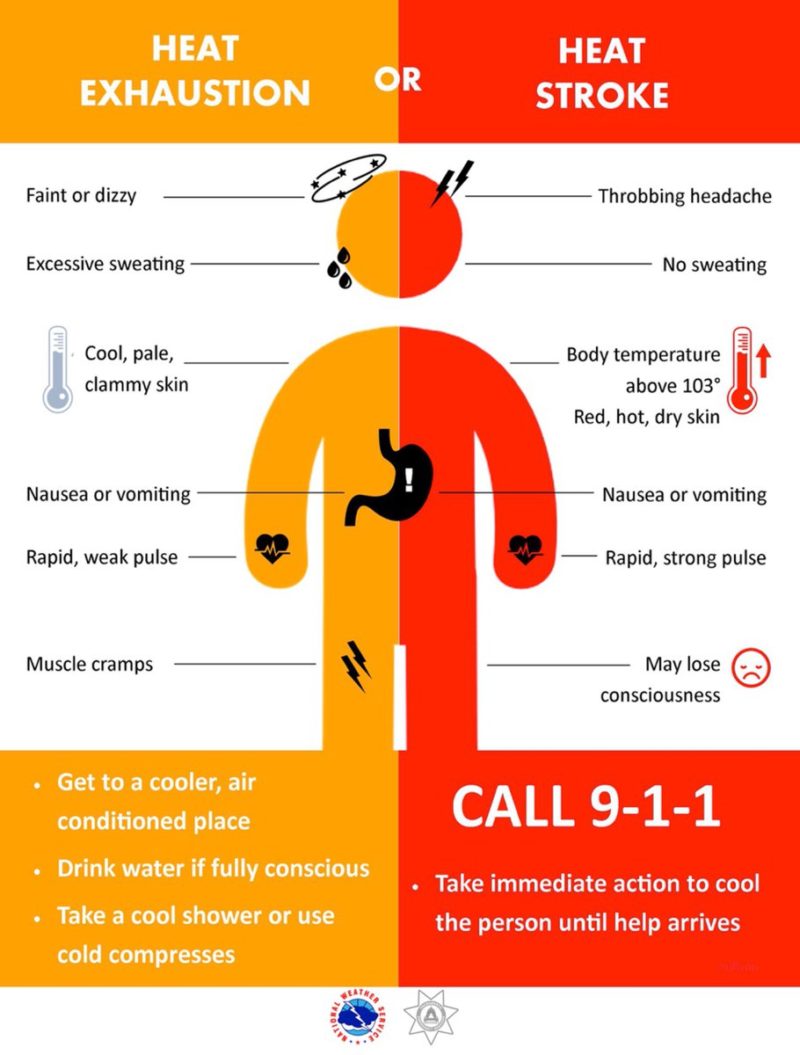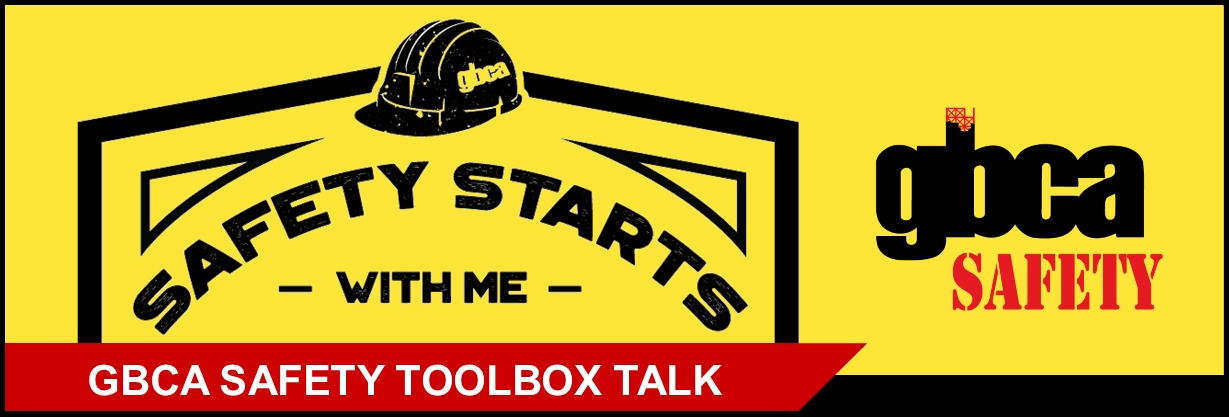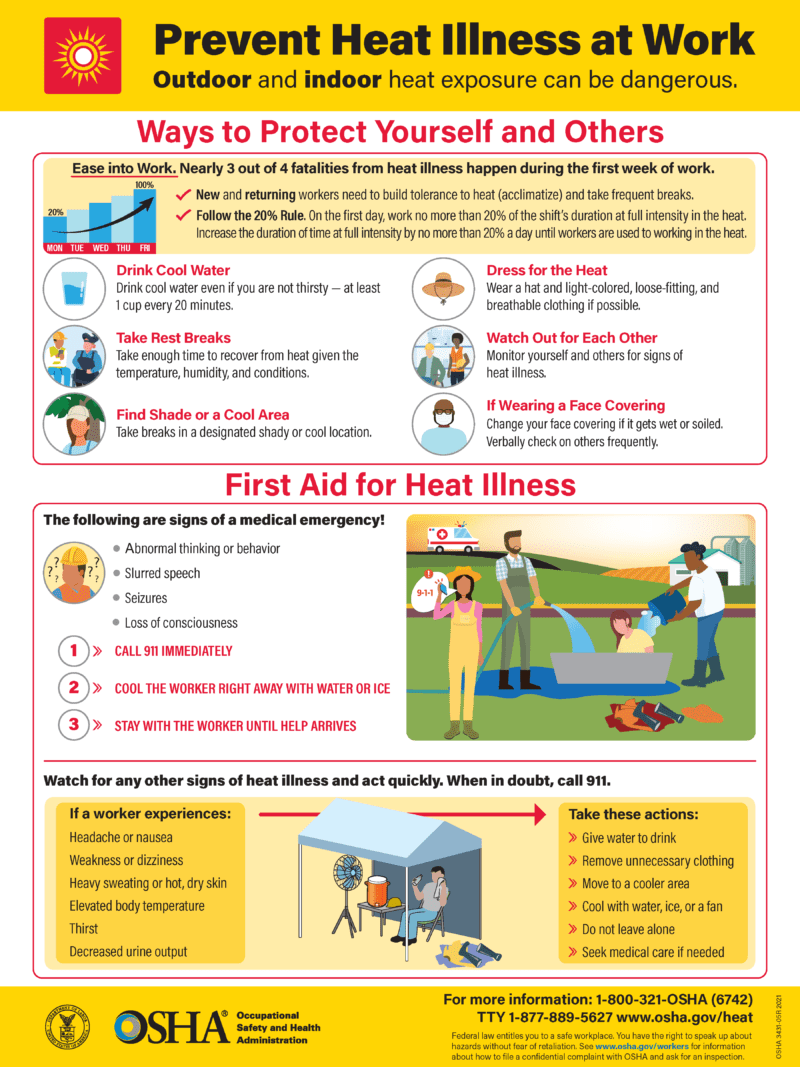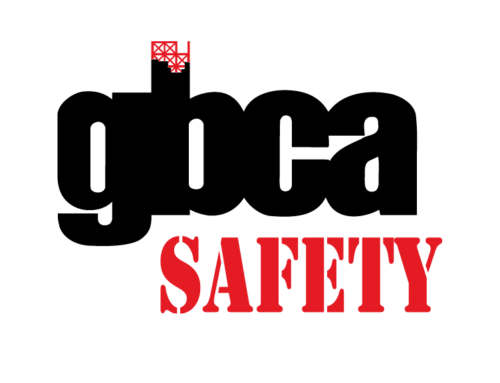This GBCA Safety Toolbox Talk discusses how to prevent heat-related illness, as well as the steps to take to provide first aid to someone who becomes sick with a heat-related illness. Click below to download the Toolbox Talk as a multi-page handout.
Preventing Heat-Related Illness
Construction workers are prone to heat-related illnesses in various high temperature settings, such as outdoors on rooftops or in open excavation sites in the sun. Indoors, workers may be in non-air conditioned or poorly ventilated rooms near heat-producing machinery.
In a warm environment, especially when physically active, the human body relies on its ability to get rid of excess heat (heat dissipation) to maintain a healthy internal body temperature. Heat dissipation happens naturally through sweating and increased blood flow to the skin. Workers cool down more rapidly if the environment’s temperature and their physical activity are reduced. If heat dissipation does not happen quickly enough, the internal body temperature keeps rising and the worker may be at risk of a heat-related illness.
Employers and workers should be familiar with the heat-related illness symptoms. When any of these symptoms is present, promptly provide first aid. Do not spend time trying to diagnose which illness is occurring – the primary response for these illnesses is the same and time is of the essence. These conditions can worsen quickly and result in fatalities. When in doubt, cool the worker and call 911.
Heat-Related Illnesses
Some of the symptoms of heat-related illnesses are non-specific. This means that when a worker is performing physical labor in a warm environment, any unusual symptom can be a sign of overheating. Here are some common heat-related illnesses, from most severe to least:
Heat Stroke
- Confusion
- Disorientation
- Slurred speech
- Unconsciousness
- Seizures
- Heavy sweating or hot, dry skin
- Very high body temperature
- Rapid heart rate
Heat Exhaustion
- Fatigue
- Irritability
- Thirst
- Nausea or vomiting
- Dizziness or lightheadedness
- Heavy sweating
- Elevated body temperature or fast heart rate
Heat Cramps
- Muscle spasms or pain
- Usually in legs, arms, or trunk
Heat Syncope
- Fainting
- Dizziness
Heat Rash
- Clusters of red bumps on skin
- Often appears on neck, upper chest, and skin folds
Rhabdomyolysis (Muscle Breakdown)
- Muscle pain
- Dark urine or reduced urine output
- Weakness
Preventing Heat-Related Illnesses
- Know the symptoms of heat-related illnesses
- Block out sun or other heat sources
- Use fans or air conditioning units
- In high heat, drink 1 cup of water every 15 minutes
- Drink electrolytes if working in heat for longer than 2 hours
- Avoid alcohol, caffeinated drinks, or heavy meals
- Wear lightweight, light colored, loose fitting clothes. Wear tightly woven fabrics to block out the sun if working outside
- Wear sunscreen of SPF 15 or higher and reapply every 2 hours
First Aid for Heat-Related Illnesses
OSHA’s Medical Services and First Aid standard and the Medical Service and First Aid in Construction require the ready availability of first aid personnel and equipment. You are more likely to recognize these symptoms in others than yourself, so response will usually be in the aid of your coworkers.
Heat stroke is the most severe heat-related illness, and common signs are confusion, slurred speech, or unconsciousness. If you see these types of symptoms, call 911 immediately and cool the worker with ice or cold water until help arrives.
In general, follow these steps to provide first aid for heat-related illness:
- Take the affected worker to a cooler area (e.g. shade or air conditioned room).
- Cool the worker immediately. Use active cooling techniques such as:
- Immerse the worker in cold water or an ice bath. Create the ice bath by placing all of the available ice into a large container with water, standard practice in sports. This is the best method to cool workers rapidly in an emergency.
- Remove outer or tight-fitting layers of clothing, especially heavy protective clothing.
- Place ice or cold wet towels on the head, neck, trunk, armpits, and groin.
- Use fans to circulate air around the worker.
- Seek medical attention immediately.
- Never leave a worker with heat-related illness alone. The illness can rapidly become worse. Stay with the worker.
- When in doubt, call 911!
Look Out for One Another
Many of the symptoms for heat-related illnesses can be easier to recognize in others than in yourself.
Workers who are new to working in warm environments are at increased risk of heat-related illness. Especially during a worker’s first few days, absolutely all symptoms should be taken seriously. Workers who develop symptoms should be allowed to stop working. They should receive evaluation for possible heat-related illness.
Learn more about heat-related illnesses from OSHA.

Image Credit: National Weather Service
Remember to record the attendees of your toolbox talk!
Access GBCA’s full library of toolbox talks:






